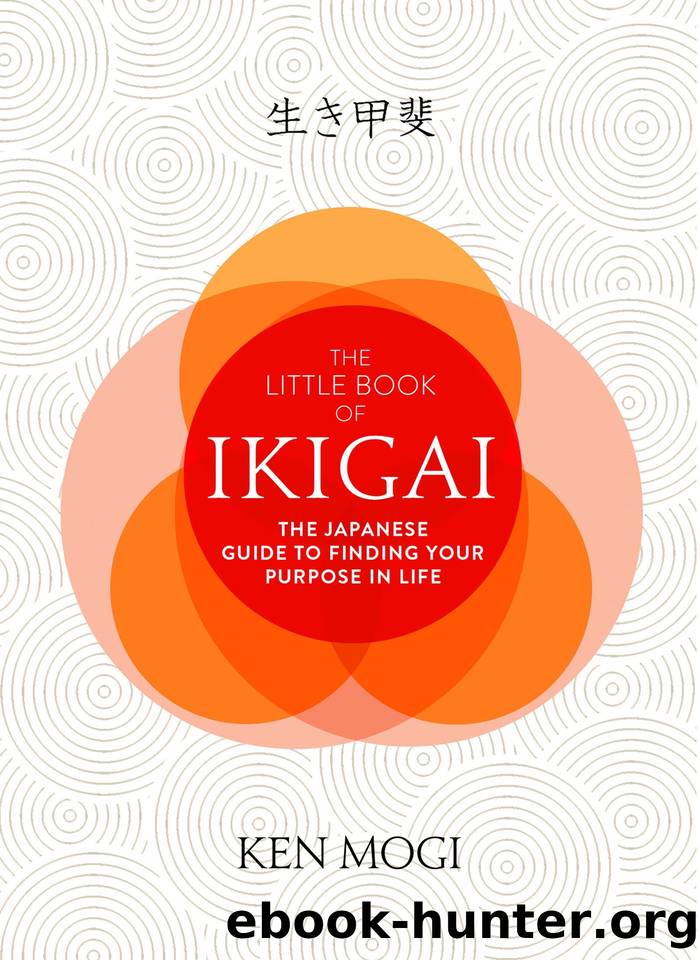The Little Book of Ikigai: The secret Japanese way to live a happy and long life by Mogi Ken

Author:Mogi, Ken [Mogi, Ken]
Language: eng
Format: epub
Publisher: Quercus
Published: 2017-09-06T16:00:00+00:00
CHAPTER 6
Ikigai and sustainability
CHAPTER 6: Ikigai and sustainability
Crucially, the Japanese conception of ikigai has always been one of reservation and self-restraint, where harmony with others is considered to be of primary importance. In a world where economic asymmetries have led to a widespread social unrest, Japan has traditionally remained a nation of modest means, despite its economic success in the past. For a long time, a majority of Japanese perceived themselves as belonging to the middle class. In recent years, with the slowdown of economic growth and aging of the population, there has been a growing awareness that economic asymmetry is increasing, and several metrics are consistent with that perception. However, extravagant spending by the rich or displays of exhibitionism by the famous are relatively rare in Japan, at least in perception. Japan has only a subdued celebrity culture. There are no Justin Biebers or Paris Hiltons, although Japan does have its share of celebrities on a diminished scale.
Curbing individual desires and ambitions might have negative side effects. Compared to the global success of such companies as Google, Facebook, and Apple, startups in Japan in recent years have had a relatively small impact. Maybe the Japanese spectrum of success and glamour is too narrow to accommodate true game changers on a global scale.
Closely connected to the subdued expression of individual freedom and success, to reservation and self-restraint, is one of Japanâs most unique values: sustainability. The pursuit of individual desires is more often than not balanced with the sustainability of society and environment. After all, without a robust and healthy society and environment, you cannot pursue your goals, and aim to achieve your ambitions.
As we have seen earlier, on an individual level, ikigai is a motivational structure to keep you going, to help you get up in the morning and start doing chores. In Japanese culture, in addition, ikigai has much to do with being in harmony with the environment, with people around you and with society at large, without which sustainability is impossible. The third pillar of ikigai , harmony and sustainability , is perhaps the most important and uniquely developed ethos of the Japanese mindset.
Let us consider the Japanese relationship with nature. The Japanese have made the restraint of individual wants into an art form of modesty, austere aesthetics and elegant sufficiency. In Japanese idealism, there is an abundance of understated beauty, wabi sabi . The smooth untreated wood of a sushi counter is a quintessential example. The fragrant hinoki wood used in baths, combined with the peeled skins of yuzu orange fruit, is another one â and a heavenly one at that. The purpose of such a bath is not just to be clean, but to relax. Bathing outdoors in nature is quite popular, especially at onsen (hot springs). In urban areas, bringing nature indoors to fill the interior with simple luxury and comfort is very common. You will often find paintings of Mt Fuji on the walls of sento (public baths), for example â a very popular artistic trick.
Download
This site does not store any files on its server. We only index and link to content provided by other sites. Please contact the content providers to delete copyright contents if any and email us, we'll remove relevant links or contents immediately.
Spare by Prince Harry The Duke of Sussex(5078)
Machine Learning at Scale with H2O by Gregory Keys | David Whiting(4197)
Fairy Tale by Stephen King(3223)
Will by Will Smith(2795)
Hooked: A Dark, Contemporary Romance (Never After Series) by Emily McIntire(2502)
The Bullet Journal Method by Ryder Carroll(2487)
Rationality by Steven Pinker(2291)
Can't Hurt Me: Master Your Mind and Defy the Odds - Clean Edition by David Goggins(2230)
It Starts With Us (It Ends with Us #2) by Colleen Hoover(2204)
Friends, Lovers, and the Big Terrible Thing by Matthew Perry(2126)
The Becoming by Nora Roberts(2091)
Love on the Brain by Ali Hazelwood(1965)
HBR's 10 Must Reads 2022 by Harvard Business Review(1779)
The Strength In Our Scars by Bianca Sparacino(1778)
A Short History of War by Jeremy Black(1764)
Leviathan Falls (The Expanse Book 9) by James S. A. Corey(1651)
515945210 by Unknown(1602)
A Game of Thrones (The Illustrated Edition) by George R. R. Martin(1594)
Bewilderment by Richard Powers(1541)
